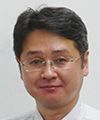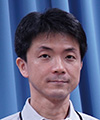 |
|||||||||||
|
|
|||||||||||
|
Feature Articles: Ultra-realistic Communication with Kirari! Technology Vol. 16, No. 12, pp. 29–35, Dec. 2018. https://doi.org/10.53829/ntr201812fa5 Video Processing/Display Technology for Reconstructing the Playing Field in Sports Viewing Service Using VR/ARAbstractSports viewing services using virtual reality (VR) and augmented reality (AR) technology have been introduced recently due to the development of sensor devices and video production/delivery technology. NTT Media Intelligence Laboratories aims to provide a sports viewing service using VR/AR to display reconstructed playing field videos without user operation. In this article, we present a video processing technology to reconstruct the playing field for VR/AR displays and a three-dimensional display technology for representing a playing field three-dimensionally on a table. Keywords: virtual reality/augmented reality, video processing technology, 3D display technology 1. IntroductionAdvances in sensor devices and video production and delivery technology have led to the introduction of sports viewing services using virtual reality (VR) and augmented reality (AR) technologies. NTT DOCOMO demonstrated an AR sports viewing service for rugby games that displays player information and video in a high visibility area through a user’s smart glass [1]. KDDI has already launched a VR sports watching service that provides VR views while switching among viewpoints from five cameras in a baseball stadium [2]. However, neither AR nor VR can cover all of the game scenes in a stadium because suitable scenes for VR/AR change in response to the constantly varying game state. To enable viewers to have a good game watching experience, it should be possible to change VR/AR viewing modes without any need for user operation. NTT Media Intelligence Laboratories thus aims to give the crowd in the sports stadium an additional element of excitement by using VR/AR to display reconstructed playing field videos without user operation. To achieve this, we have been studying video processing technology to generate common content for VR and AR, as well as video display technology to create a feeling of physical presence, as if real objects were actually there. In this article, we first give an overview of a sports viewing system we developed that uses VR/AR. We then present a three-dimensional (3D) reconstruction technology we developed as a means for processing videos to reconstruct the playing field for VR/AR displays. It generates arbitrary viewpoint images from places where cameras cannot be placed on the playing field. We also describe our diminished reality technology that focuses on particular players by removing everything except the players from the video. Finally, we introduce a novel visually equivalent light field 3D display technology that we propose as a future AR method for representing a playing field three-dimensionally on a table. 2. Overview of sports viewing systemOur system for watching sports in a stadium using VR/AR technologies is shown in Fig. 1. It features multiple cameras that surround the stadium and capture videos of the playing field. The videos are delivered to a server on a cloud. The server uses the videos to analyze the event that occurred on the playing field and selects the videos to provide to the users from the analysis results. The playing field is then reconstructed from the videos based on preprocessing results and distributed to the user viewing devices.
3. 3D reconstruction technology for the playing fieldOne of the video processing technologies used to reconstruct the playing field is 3D reconstruction technology. It enables viewpoint images to be generated from places inside the playing field where cameras cannot be installed. Since the spectators’ seats are fixed in stadiums and arenas, the spectators can only watch the event going on from a limited direction. They cannot see players if their seats are far away from the playing field, and often cannot watch the event from the viewpoint they would like in order to get the best view of how the event is developing. A method has been developed to generate arbitrary viewpoint images from multiple cameras that surround the playing field. However, it requires the installation of a very large number of cameras, which is difficult to do in a stadium. Also, the method cannot generate high quality viewpoint images of what is happening in front of the camera because of insufficient video resolution and because 3D information cannot do estimations in occluded areas. To address these problems, we propose a new form of 3D reconstruction technology based on computer graphic (CG) characters. It estimates a player’s motions from videos and applies the estimation results to a preprepared high quality CG model of the player. With the notably improved CG quality for movies and games achieved in recent years, our method generates high quality viewpoint images that make users feel as if they were watching scenes in the real world. To achieve this, it is necessary to estimate player motions from videos. While conventional methods have been proposed to estimate human motions from videos using deep learning [3], the pose estimation accuracy they provide is substantially reduced when the people being videoed are partly occluded by objects. An important task is to improve robustness in occluded areas, because in sports scenes many athletes are frequently intertwined in one scene and can easily shield each other. Thus, we propose the idea of estimating athletes’ motions not from color images directly but from color images and silhouette images of people, including those in occluded areas (Fig. 2). By using silhouette images to limit the area for searching human motions, our method achieves higher human motion estimation accuracy than conventional ones can provide.
4. Diminished reality technology for the playing fieldHere, we describe the diminished reality technology we developed that removes unnecessary players and objects from videos in order to focus on target players. In movie and cartoon scenes, only the persons to be focused on remain in the scene, and effects such as a spotlight are added. We anticipate that applying this to sports events held in stadiums and arenas will ensure that increased attention is directed towards players involved in decisive moments of the game, which will make watching the game more exciting. Diminished reality (DR) technology removes unnecessary target regions from video images and reconstructs the missing regions with background images. To apply this to sports events, DR technology must reconstruct only target regions while considering the relationship between players in 3D space. Furthermore, since spectators watch sports events in various positions and postures, it needs to present images in which the target region does not stand out above all others for each spectator’s viewpoint. To address these points, we propose a DR method that selects the optimal camera capturing the background of the target region from multiple cameras installed in a stadium and overlays the transformed image so that it matches that seen from the user viewpoint. This prevents the target region from becoming overly conspicuous [4]. The technical features of our proposed method are shown in Fig. 3. The first feature is that the playing field is treated as a multilayered plane, and 3D information is estimated on that basis, since a wide range of depth is unnecessary to reconstruct the playing field. This enables it to select the group of cameras capturing the background of the target region with less calculation than that needed in methods estimating 3D information of the entire playing field.
The second feature is that the method automatically determines the optimum camera—one that is near the user’s location and thus catches the action from a direction and position similar to that of the user. This makes it possible to provide images that are natural from a user’s viewpoint by simply applying projective transformation to selected camera images. 5. Visually equivalent light field display technologyFinally, we introduce a novel visually equivalent light field 3D display technology, which we propose as a future AR method that three-dimensionally represents a playing field on a table. We believe that showing game highlights at the box office, lobby, or some other place outside the playing venue will increase people’s interest in certain players and teams so they will come to see them again and again. To provide spectators with a more attractive viewing experience, it is important to show them the players in a way that makes them feel as if the players were actually there in front of them. Objects such as players, fields, and balls emit rays with different colors and brightness in each direction by reflecting light or by emitting light themselves. Fields generated with these rays, called light fields, can be made to seem highly realistic by accurate ray reproduction. However, to display different rays depending on the direction, we allocate pixels in accordance with the number of directions. For example, generating rays in 100 directions requires 100 times more pixels than needed for a 2D display with the same resolution. Human vision perceives objects from incident rays entering the pupils of the eyes. This perception involves not only acquiring simple images like pictures taken by a camera, but also using differences in rays between the left and right eyes and small temporal variations of rays due to viewing position changes induced by fluctuations of posture or eye movement. This perception seems to be high at first glance but is insensitive to elements that are not necessary. Therefore, a visually equivalent light field should exist. Though it is different from the light field of an actual object, human vision perceives it as the same as that of an actual object. This is the concept of a visually equivalent light field display. With this technology, light rays to an intermediate viewpoint are interpolated with visual equivalence. The interpolation is a weighted average of rays to discrete viewpoints that is optically created in the display [5]. An overview of a visually equivalent light field display is given in Fig. 4. As shown in the top left corner, the display consists of an LCD (liquid crystal display) panel, a stripe-pattern barrier, and a backlight, in order from the rear. When an observer’s pupils are at viewpoint A, rays from the barrier spacing illuminate the pixels of the viewpoint A image only, and that image can be seen. When an observer’s pupils are at viewpoint B, the image for viewpoint B can be seen. When an observer’s pupils are midway between viewpoints A and B, the pixels for both images A and B are partially illuminated, and a weighted average is achieved. Since the weights depend on the distance between pupil position and viewpoints A and B, an intermediate viewpoint image is perceived as expected. Because the image quality is high when a displayed object is close to the display panel, we placed the panel horizontally as shown at the bottom left in the figure. This made it possible to display and maintain high resolution, high quality images in every corner of the court.
Reproducing the light field in this way enables the correct depth to be perceived even if the distance between the left and right eyes is different (e.g., for an adult and a child). We believe the efficacy of interpolation can not only improve pixel usage efficiency but also improve feelings of object existence or reality. 6. Future workWe have improved VR/AR technologies and expect that sports viewing services using them will increase as interest in sports increases with the approach of the major international sports event in 2020. The research on scene analysis technology NTT Media Intelligence Laboratories is conducting will facilitate the selection of video effects and VR/AR displays that will accord with game situations. The development of video processing technology will facilitate the reconstruction of playing fields and visually equivalent light field 3D displays. This will enable us to contribute to the development of innovative ways to provide people with a new and enhanced sports watching experience. References
|
|||||||||||



















